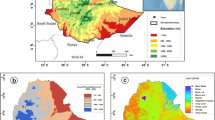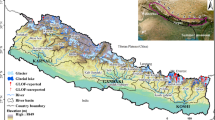Abstract
In this paper we present an analysis of the direct impacts of climate change on the hydrology of the upper watersheds (range in elevation from 1,000 to 5,500 m above sea level) of the snowmelt-driven Limarí river basin, located in north-central Chile (30° S, 70° W). A climate-driven hydrology and water resources model was calibrated using meteorological and streamflow observations and later forced by a baseline and two climate change projections (A2, B2) that show an increase in temperature of about 3–4°C and a reduction in precipitation of 10–30% with respect to baseline. The results show that annual mean streamflow decreases more than the projected rainfall decrease because a warmer climate also enhances water losses to evapotranspiration. Also in future climate, the seasonal maximum streamflow tends to occur earlier than in current conditions, because of the increase in temperature during spring/summer and the lower snow accumulation in winter.
Similar content being viewed by others
References
Aceituno P (1988) On the functioning of the Southern Oscillation in the South American Sector, part I: surface climate. Mon Weather Rev 116:505–524
Barnett TP, Adam JC, Lettenmaier DP (2005) Potential impacts of a warming climate on water availability in snow-dominated regions. Nature 438:303–309
CAZALAC (2006) Aplicación de metodologías para determinar la eficiencia de uso del agua estudio de caso en la región de Coquimbo, Elaborado por CAZALAC; con la asesoría de RODHOS Asesorías y Proyectos Ltda; Gobierno Regional - Región de Coquimbo, p 893
Christensen JH, Hewitson B, Busuioc A, Chen A, Gao X, Held I, Jones R, Kolli RK, Kwon RT, Laprise R, Magaña V, Mearns CG, Menendez CG, Raisanen J, Rinde A, Sarr A, Whetton P (2007) Regional climate projections’. In: Climate change 2007: the physical science basis. Contribution of working group I to the fourth assessment report of the intergovernmental panel on climate change. Cambridge University Press, New York
Falvey M, Garreaud R (2007) Wintertime precipitation episodes in Central Chile: associated meteorological conditions and orographic influences. J Hydrometeorol 8:171–193
Favier V, Falvey M, Rabatel A, Praderio E, López D (2009) Interpreting discrepancies between discharge and precipitation in high-altitude area of Chile’s Norte Chico region (26–32°S). Water Resour Res 45:W02424. doi:10.1029/2008WR006802
Fuenzalida H, Aceituno P, Falvey M, Garreaud R, Rojas M, Sanchez R (2007) ‘Study on Climate Variability for Chile during the 21st century’. Technical Report prepared for the National Environmental Committee (in Spanish). Available on-line at http://www.dgf.uchile.cl/PRECIS (August 2007)
Garreaud R (1992) Estimación de la altura de la línea de nieve en cuencas de Chile central’. Rev Chil Ing Hidráulica 7:21–32
Gordon C, Cooper C, Senior CA, Banks J, Gregory JM, Johns TC, Mitchell JFB, Wood RA (2000) The simulation of SST, sea ice extent and ocean heat transport in a version of the Hadley Centre coupled model without flux adjustments. Clim Dyn 16:147
Jones RG, Noguer M, Hassell DC, Hudson D, Wilson SS, Jenkins GJ, Mitchell JFB (2004) Generating high resolution climate change scenarios using PRECIS. Met. Office Hadley Center, Exeter, p 40
Nakicenovic N, Swart R (eds) (2000) Special report on emissions scenarios. Cambridge University Press, New York
Parry ML, Canziani OF, Palutikof JP et al (2007) Technical summary. In: Parry ML, Canziani OF, Palutikof JP, van der Linden PJ, Hanson CE (eds) Climate change 2007: impacts, adaptation and vulnerability. Contribution of working group II to the fourth assessment report of the intergovernmental panel’ on climate change. Cambridge University Press, Cambridge, pp 23–78
Pope VD, Pamment JA, Jackson DR, Slingo A (2001) The representation of water vapor and its dependence on vertical resolution in the Hadley Centre Climate Model. J Climate 14:3065–3085
Purkey D, Joyce B, Vicuna S, Hanemann M, Dale L, Yates D, Dracup JA (2008) Robust analysis of future climate change impacts on water for agriculture and other sectors: a case study in the Sacramento Valley. Clim Change 87:109–122
Rutllant J, Fuenzalida H (1991) Synoptic aspects of central rainfall variability associated with the Southern Oscillation. Int J Climatol 11:63–76
Stewart IT, Cayan DR, Dettinger MD (2005) Changes toward earlier streamflow timing across Western North America. J Climate 18(8):1136–1155
Vera C, Silvestri G, Liebmann B, González P (2006) Climate change scenarios for seasonal precipitation in South America from IPCC-AR4 models. Geophys Res Lett 33:13
Vicuna S, Dracup JA (2007) The evolution of climate change impact studies on hydrology and water resources in California. Clim Change 82(3–4):327–350
Weglarczyk S (1998) The interdependence and applicability of some statistical quality measures for hydrological models. J Hydrol 206:98–103
Wigley TML, Jones PD (1985) Influences of precipitation changes and direct CO2 effects on streamflow. Nature 314:149–152
Yates D (1996) WatBal: an integrated water balance model for climate impact assessment of river basin runoff. Water Resour Dev 12(2):121–139
Yates D, Sieber J, Purkey D, Huber-Lee A, Galbraith H (2005a) WEAP21: a demand, priority, and preference driven water planning model: part 2, Aiding freshwater ecosystem service evaluation. Water Int 30(4):487–500
Yates D, Sieber J, Purkey D, Huber-Lee A (2005b) WEAP21: a demand, priority, and preference driven water planning model: part 1, model characteristics. Water Int 30(4):501–512
Yates D, Purkey D, Sieber J, Huber-Lee A, Galbraith H, West J, Herrod-Julius S, Young C, Joyce B, Rayej M (2009) Climate driven water resources model of the Sacramento Basin, California. J Water Resour Plan Manage 135(5):303–313
Young CA, Escobar-Arias MI, Fernandes M, Joyce B, Kiparsky M, Mount JF, Mehta VK, Purkey D, Viers JH, Yates D (2009) Modeling the hydrology of climate change in California’s Sierra Nevada for subwatershed scale adaptation. J Am Water Resour Assoc (JAWRA) 45(6):1409–1423
Author information
Authors and Affiliations
Corresponding author
Rights and permissions
About this article
Cite this article
Vicuña, S., Garreaud, R.D. & McPhee, J. Climate change impacts on the hydrology of a snowmelt driven basin in semiarid Chile. Climatic Change 105, 469–488 (2011). https://doi.org/10.1007/s10584-010-9888-4
Received:
Accepted:
Published:
Issue Date:
DOI: https://doi.org/10.1007/s10584-010-9888-4




